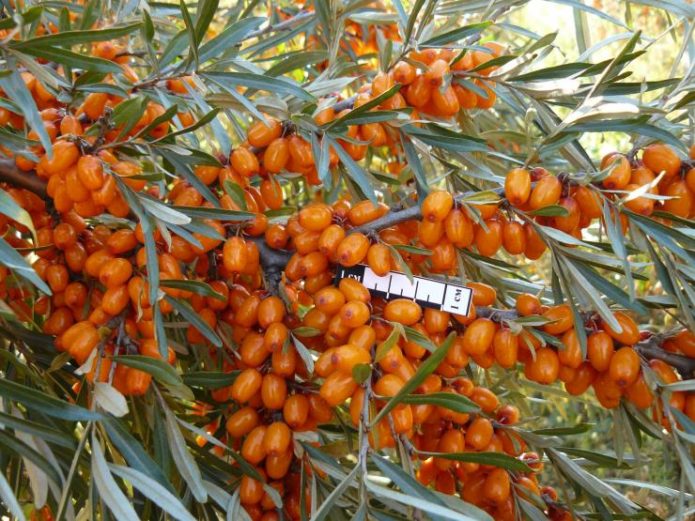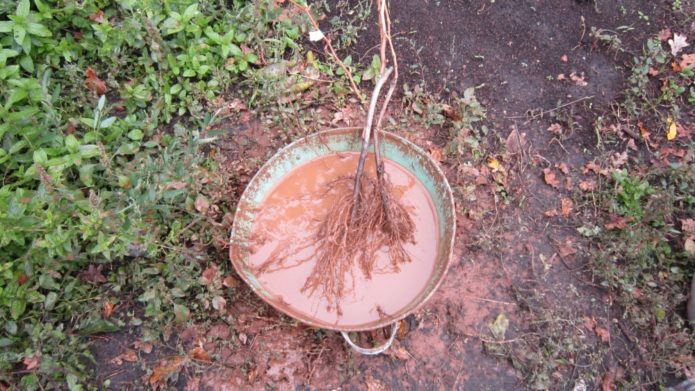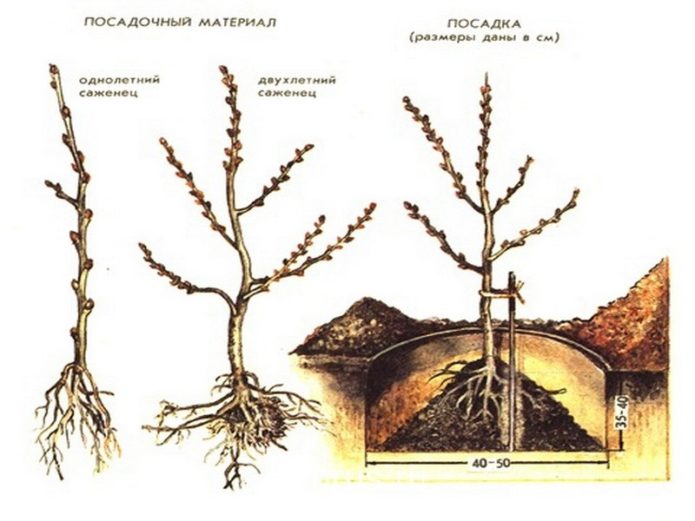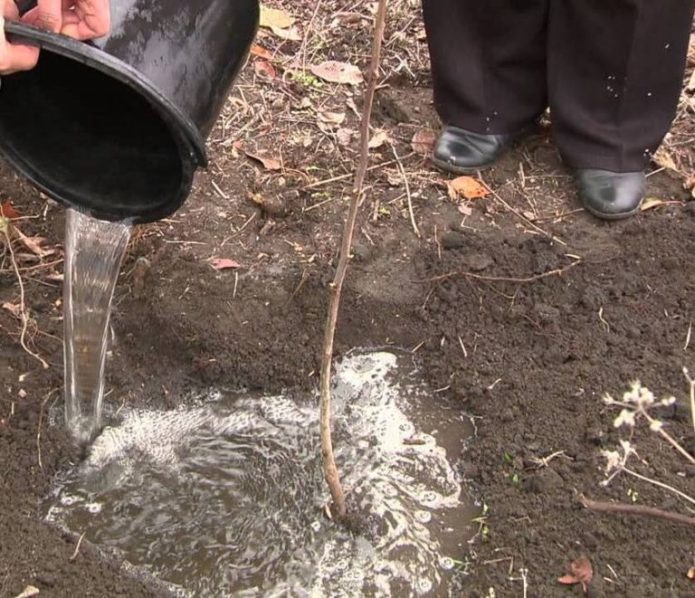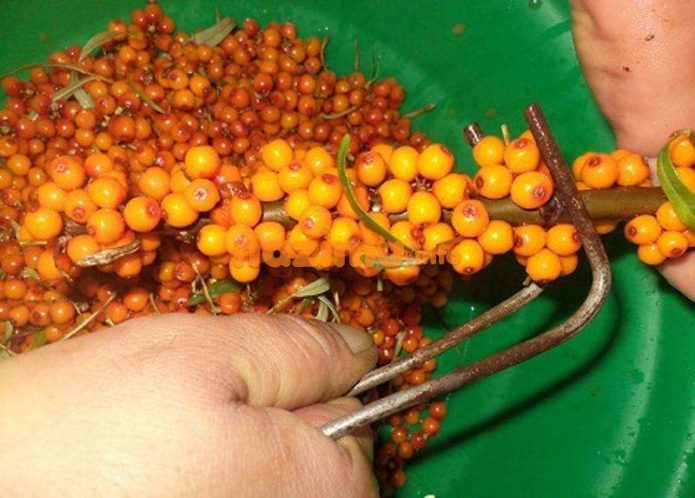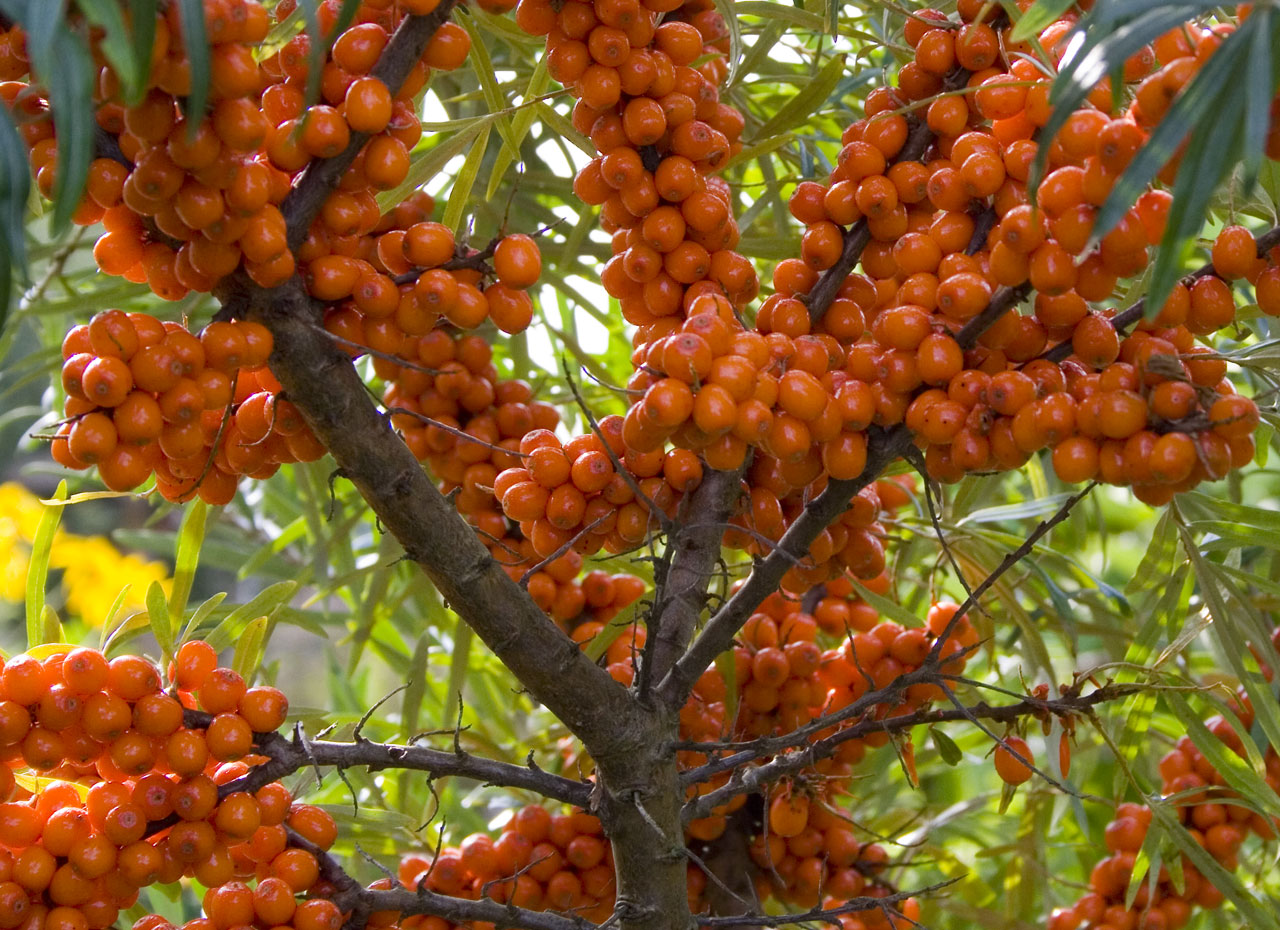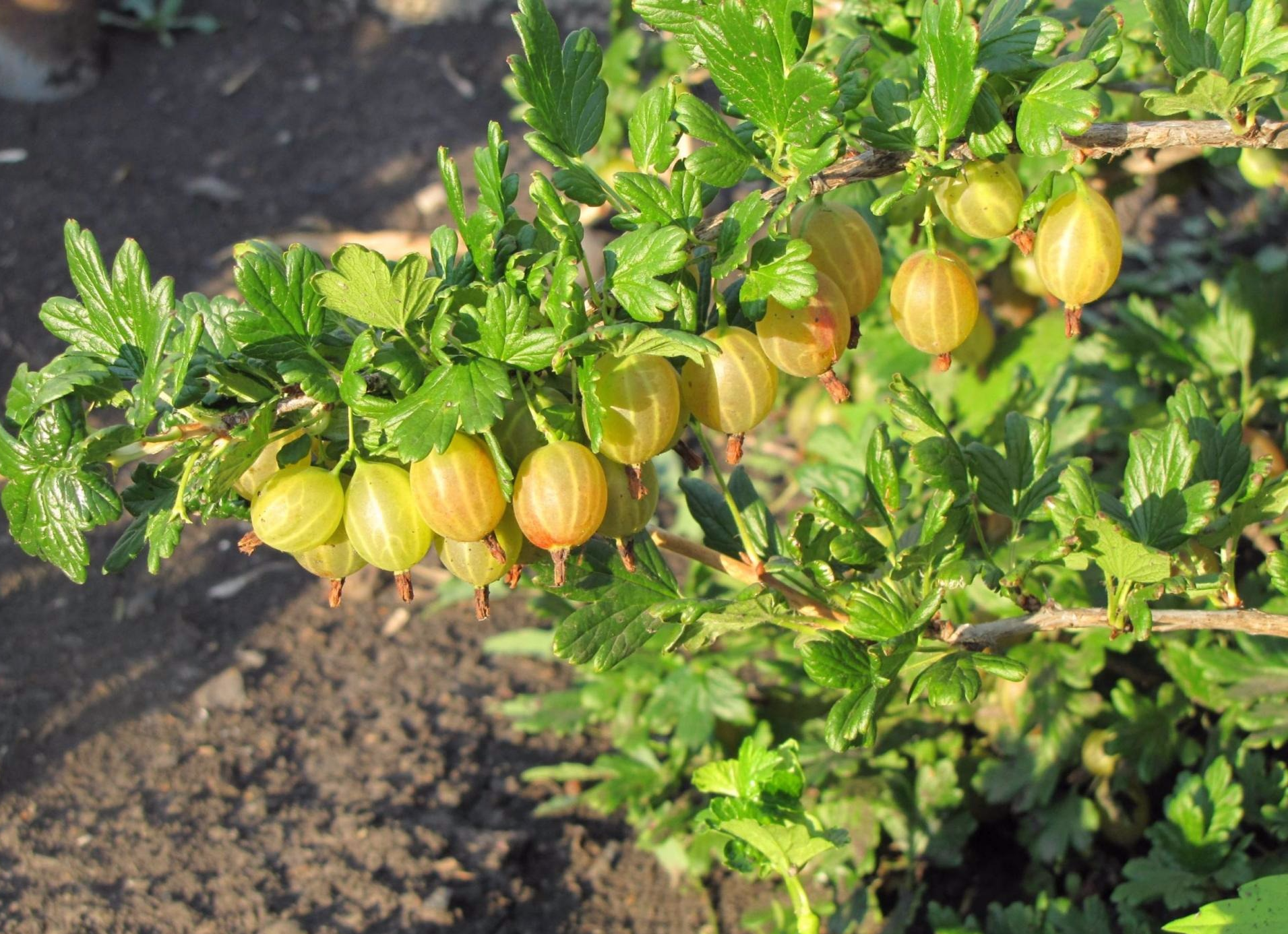Sea buckthorn is one of the healthiest berries known. This unpretentious culture grows both in the wild and in the gardens of summer residents throughout our country. Many amateurs try to settle it on their site, since sea buckthorn does not require super complicated care. One of the most popular varieties is Altai.
Content
Characteristics of the Altai sea buckthorn variety
More than fifty varieties of sea buckthorn are known, grown in various regions of our country, but not so many are known. Altai sea buckthorn is one of the varieties that every gardener who is interested in this berry culture knows about.
Growing history
Altai is a relatively young variety. True, he was born already in 1981, but passed state tests for a long time and was registered in the State Register of Breeding Achievements of the Russian Federation only in 2006. The variety was created in the Scientific Research Center named after M.A.Lisavenko (Altai) based on Shcherbinka-1 sea buckthorn. It is recommended for cultivation in the West Siberian region, however, the Ural, East Siberian and Far Eastern regions are also classified as admission regions.
Over the past years, they tried to plant Altai sea buckthorn in many climatic regions, now it can be found in the European part of our country.
Plant characteristic
Altai sea buckthorn grows in the form of a low-thorn shrub of medium height: the height of an adult plant is from 3 to 4 meters. Young shoots are silvery-gray, later they become brownish, the bark is smooth. The crown is compact but dense. Lanceolate gray-green leaves are on short petioles, narrow, up to 6 cm in length.
It tolerates any pruning painlessly, so the bush can be given any desired shape. Plasticity allows the plant to be used both for obtaining berries and in landscape design. The variety is characterized by increased disease resistance, practically not susceptible to pest attacks. Withstands frosts down to -45 aboutFROM.
Whitish small flowers with a faint odor bloom before the leaves, arranged singly or in small groups. In the middle lane, this happens in mid-May, in colder climates - a little later. Flowering lasts about 2 weeks. The ripening variety belongs to the late summer: the berries are ready for harvest at the very end of August or early September. The first harvest can be expected in the fourth year after planting, after another 2 years the sea buckthorn enters the age of normal fruiting.
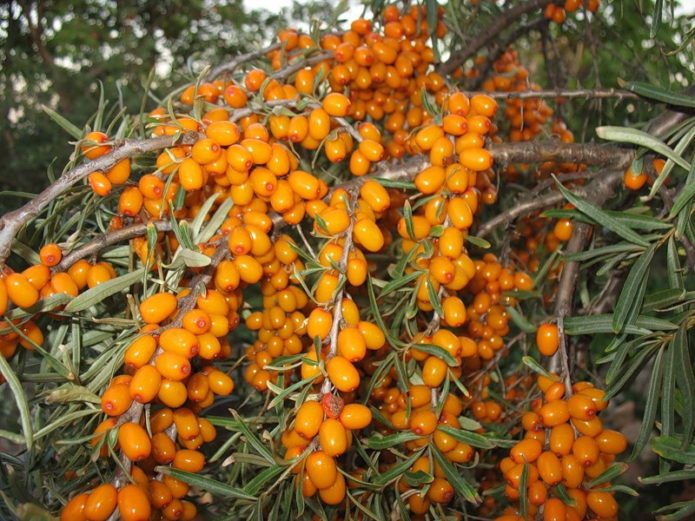
The number of berries in Altai and the nature of their location fully corresponds to the word "sea buckthorn"
The yield of the variety in the presence of pollinators is high. The best varieties in this regard are Alei, Dear friend, Ural, Adam. From an adult Altai bush
up to 16 kg of berries are harvested, with industrial cultivation an average of 70 c / ha. Pollinators are planted from the side of the prevailing winds on the site.
Description of berries
The fruits of Altai sea buckthorn have a classic shape and color, they are tightly pressed both to each other and to the branches. They are oval, bright orange, of medium size, weighing about 0.7–0.8 g. They are easily detached from the stalks. The juice content is high, the taste is excellent. Tasting score - 5 points. Sugar in juice contains up to 10%, acids a little more than 1%. The fruits adhere firmly to the bushes, do not crumble until the very cold.
The purpose of the berries is universal. Most often, the surplus crop is processed. Sea buckthorn juice is of great importance in medicine, and this variety has especially juicy berries.
When choosing a variety of sea buckthorn, one should not confuse Altai with Altai sweet. In many respects, these varieties are similar, but Altai Sweet ripens in the second half of September and has almost half the yield.
Features of planting and cultivation of sea buckthorn varieties Altai
Both planting Altai sea buckthorn and caring for it is not difficult and is available even to a novice gardener.
Landing
Sea buckthorn is planted both in spring and autumn. And if there is a possibility of spring planting, they try to plant it in the spring: with the autumn version, young bushes do not have time to properly take root until frost, they must be covered for the winter. Bushes planted in spring usually start bearing fruit a year earlier. If we talk about the middle lane and regions similar in climate, the optimal planting dates are from mid-April to mid-May. The Altai planting technique does not differ from that for other sea buckthorn varieties.
The variety is picky about sunlight and moisture: the bushes will grow anywhere, but sufficient lighting and timely watering are needed for high-quality fruiting. Wetlands and those where melt water accumulates for a long time are undesirable for planting, but the close location of groundwater, up to 1 meter, is not an obstacle.
When planning, you should also be aware that after a few years the roots of the bush will grow strongly in all directions. Often this property is used to strengthen the soil and plant sea buckthorn on the slopes.
The soil for Altai sea buckthorn can be any, but loam or sandy loam is optimal. It is important that the soil is moisture-breathable. In terms of acidity, neutral soils are best suited, therefore, strongly acidic ones are lime in advance. If the seedling is bought in the fall, and planting is planned for the spring, you can dig it in the garden, laying it in a ditch and sprinkling it with earth to half the height.
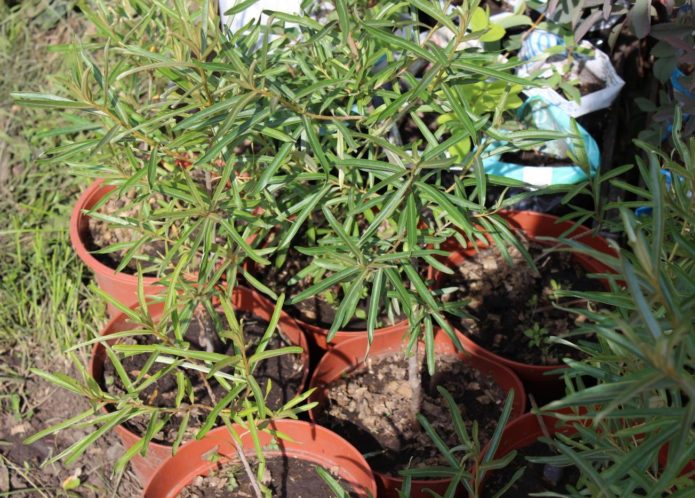
Recently, seedlings with a closed root system have also been sold, they can be planted almost always
The roots of sea buckthorn usually have nodules that look like painful growths. This is a normal situation, you do not need to delete them!
For spring planting of seedlings, it is advisable to prepare pits in the fall. For sea buckthorn varieties Altai Yama should have dimensions of about half a meter in all dimensions. The lowest layer of soil is likely to be dense clay or an infertile layer that is thrown away. And the rest of the soil is mixed with fertilizers and returned back. As fertilizers, take 2 buckets of humus or compost, 200-300 g of superphosphate and 30-40 g of potassium sulfate. When planting several plants, distances of 2.5–3 m are maintained between them, and between rows, with mass planting, 4–5 m.
During the winter, fertilizers will be well distributed in the pit under the influence of snow and water, and microorganisms will create comfortable conditions for the roots. Upon arrival in the spring with a seedling on the site, proceed as follows.
- The roots are soaked in water for several hours, and before being placed in the pit, they are dipped in a clay chatterbox.
- The required amount of soil is taken out of the pit and the seedling is placed in the pit so that the root collar is 8-10 cm below ground level.
- They spread the roots and gradually cover them with soil, evenly compact it.
- Water the seedling with 3-4 buckets of water.
- Mulch the soil around the bush with any loose material with a layer of 3-5 cm.
If you bought a seedling in a pot, the main thing is to carefully remove it with an earthen lump. Such seedlings also deepen when planting, but a little less. At the first time after planting any seedling, it is necessary to monitor the soil moisture: the roots will take root well only after two months, therefore, frequent watering of the seedling is required until mid-summer.
Video: recommendations for planting sea buckthorn
Care
Altai sea buckthorn is very unpretentious, but in order to obtain good yields, it requires systematic watering, being more moisture-loving than many other varieties. During the growing season, the plant is watered abundantly less than 5 times: if 3-4 buckets of water are enough for a young bush, then for an adult the rate increases to 8-10. Soil moisture is especially important during intensive berry growth.
Altai is a high-yielding variety, but to show all its capabilities, it needs fertile soil. Despite the introduction of solid doses of superphosphate into the planting pit, it continues to be added when loosening the trunk circle annually in an amount of 15–20 g / m2: it is the phosphorus that sea buckthorn requires for full flowering and fruit setting. Growth processes are activated in early spring by scattering 100–150 g of urea around the plant, and potassium, which is necessary for plant health, is most conveniently given in the form of wood ash. Ash is sprinkled on the trunk circle both in May and in autumn (about 100 g / m2). Humus is scattered as mulch infrequently: once every 3-4 years.
All dry fertilizers are embedded shallowly into the soil, followed by irrigation, but one must be aware that the Altai sea buckthorn root system is located in the surface layer and does not go deeper than 50 cm.Therefore, deep digging is prohibited, and even at a distance 2.5 times greater than the crown radius: the roots spread so far. You should be aware of this already when planning plantings: you should not plant any vegetables or flowers near sea buckthorn. Even under the turf, they try not to keep the Altai: throughout its life, the sea buckthorn around it weeds pull out.
A feature of the variety is a too dense crown, requiring systematic thinning. And if sanitary pruning (removal of dry and damaged branches) is not difficult, then in order to maintain high yields, it is necessary to take into account the peculiarities of fruiting. Every year in the fall, annual shoots are shortened by 20-25 cm, and after reaching the age of 8, a part of 3-4-year-old shoots is cut out, which lightens the crown and rejuvenates the plant. Formative pruning can be carried over into early spring.
In principle, from the point of view of aesthetics, you can do anything with the Altai sea buckthorn crown: experiments in this area can harm the yield, but not the viability of the plant.
They try to pick Altai berries in late autumn, after the first small frosts, despite the fact that they ripen much earlier. The only thing is that late picking is much easier to perform, and shedding ripe berries is not threatened. Connoisseurs also say that frosts give the Altai berries a slightly noticeable pineapple aroma.
Altai sea buckthorn does not require any preparation for winter, only in case of dry autumn it is advisable to carry out winter watering. Most gardeners also do not carry out preventive spraying, this sea buckthorn is so rarely sick. In the event of an invasion of sea buckthorn aphids, you can cope with folk remedies (ash and soap solution, infusion of onion peels, etc.) and only in extreme cases use insecticides, for example, Karbofos.
Video: pruning sea buckthorn
Advantages and disadvantages of the variety in comparison with similar
Altai sea buckthorn is a very popular variety due to its advantages, the main ones of which are:
- unpretentiousness in growing;
- loyal to any pruning;
- almost complete absence of thorns;
- the highest frost resistance;
- increased disease resistance;
- great taste of berries;
- very high yield;
- non-shedding and transportability of the crop.
Among the relative disadvantages, but rather only properties that cause additional difficulties for the gardener, are:
- the need to plant pollinators;
- the need for frequent watering;
- the possibility of damage as a result of a sharp onset of frost after a long winter warming.
Actually, these disadvantages are typical for many varieties of sea buckthorn. So, a variety with a similar name Altaechka does not require pollinators, but it also has smaller berries, and the yield is half as much, and, most importantly, the tasting rating of berries is only 4.0. Slightly larger berries, for example, in young varieties Augustine and Essel. Their tasters are rated at 4.7-4.8 and, perhaps, they will soon compete with the Altai one (after all, they were accepted into the State Register only 2-3 years ago!).
Of the relatively old varieties, the Lyubimaya variety has the highest rating, like the Altai one. True, her berries are slightly smaller, sugar content is lower, and pollinators are also needed. The sea buckthorn variety Velikan is also large-fruited, the main advantage of which is the complete absence of thorns. But its total yield is about half that of Altai.
Thus, it should be recognized that, despite the appearance of new varieties of sea buckthorn, Altai remains one of the leaders, which is confirmed by its high popularity and demand among gardeners.
Reviews
It is very important that the variety is bred in your area. For example, the Altai sea buckthorn, which grows well in a sharply continental climate, is poorly suited for St. Petersburg with continuous thaws, alternating frosts at 40 degrees.
I know varieties of Altai selection. Elizaveta is the largest, up to 1 g of berries, Excellent, Tenga, Altai, they have berries of 0.6-0.8 g. All varieties with a small number of thorns ...
Choose a large-fruited variety and so that the berries are on a leg - it is convenient to pick, otherwise you will be tortured with picking the berries (many of us collect such sea buckthorn only after stable frosts, in frozen form). I have Altai sea buckthorn, a type of Chuiskaya or Dar Katun, I don’t know for sure, a plot with a slope. Sea buckthorn grows in the upper part from the north side. the earth is also loam.
Altai sea buckthorn has a lot of advantages that made it desirable in amateur gardens. The most important of them are the excellent taste of berries and unpretentiousness, which makes it possible to recommend the variety even to inexperienced gardeners.
